-
 Bitcoin
Bitcoin $113900
-1.39% -
 Ethereum
Ethereum $3517
-4.15% -
 XRP
XRP $3.009
1.59% -
 Tether USDt
Tether USDt $0.9997
-0.04% -
 BNB
BNB $766.8
-1.41% -
 Solana
Solana $164.6
-2.38% -
 USDC
USDC $0.9998
-0.02% -
 TRON
TRON $0.3277
0.65% -
 Dogecoin
Dogecoin $0.2023
-1.67% -
 Cardano
Cardano $0.7246
0.05% -
 Hyperliquid
Hyperliquid $38.27
-4.77% -
 Sui
Sui $3.528
-0.52% -
 Stellar
Stellar $0.3890
-0.73% -
 Chainlink
Chainlink $16.16
-2.69% -
 Bitcoin Cash
Bitcoin Cash $539.9
-4.38% -
 Hedera
Hedera $0.2425
-2.00% -
 Avalanche
Avalanche $21.71
-0.97% -
 Toncoin
Toncoin $3.662
5.73% -
 Ethena USDe
Ethena USDe $1.000
-0.02% -
 UNUS SED LEO
UNUS SED LEO $8.964
0.35% -
 Litecoin
Litecoin $107.7
2.33% -
 Shiba Inu
Shiba Inu $0.00001223
-0.40% -
 Polkadot
Polkadot $3.617
-0.97% -
 Uniswap
Uniswap $9.052
-2.49% -
 Monero
Monero $295.1
-3.79% -
 Dai
Dai $0.9999
0.00% -
 Bitget Token
Bitget Token $4.315
-1.85% -
 Pepe
Pepe $0.00001060
0.11% -
 Cronos
Cronos $0.1342
-2.72% -
 Aave
Aave $256.0
-0.87%
What does the rising ADX in the DMI indicator mean? Is the trend going to strengthen?
A rising ADX indicates strengthening trend momentum, but direction must be confirmed with +DI and -DI crossovers for accurate crypto trading signals.
Jun 14, 2025 at 02:14 am
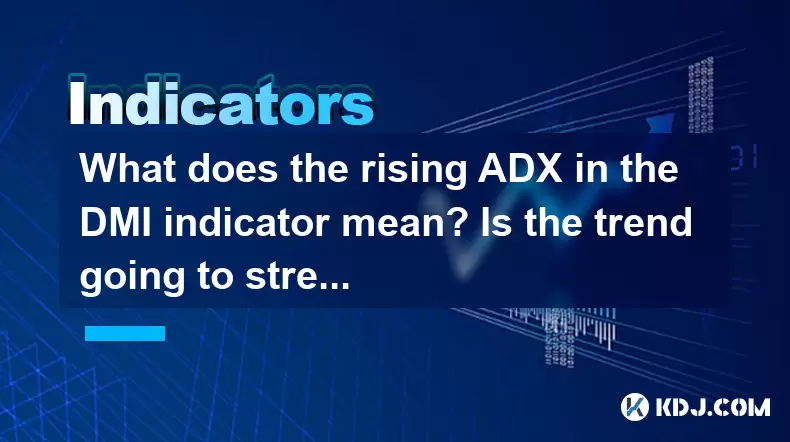
Understanding the DMI Indicator and ADX
The Directional Movement Index (DMI) is a technical analysis tool used to identify the direction and strength of a trend. It consists of two lines: the Positive Directional Indicator (+DI) and the Negative Directional Indicator (-DI). Alongside these, the ADX line measures the strength of the trend, regardless of its direction.
When traders observe a rising ADX, it indicates that the current trend — whether bullish or bearish — is gaining strength. The ADX itself does not indicate the direction of the trend, only its magnitude. A reading above 25 typically signals a strong trend, while values below 20 suggest a weak or non-trending market.
Interpreting Rising ADX in Cryptocurrency Markets
In the volatile world of cryptocurrencies, trends can form quickly and fade just as fast. A rising ADX suggests that price movement is becoming more directional, meaning buyers or sellers are exerting consistent pressure. For example, if Bitcoin's price has been fluctuating within a narrow range but suddenly breaks out with increasing volume and momentum, the ADX will rise accordingly.
It’s crucial to remember that a rising ADX doesn't automatically confirm a reversal or continuation of a trend. Instead, it reflects the intensity of directional movement. Therefore, combining DMI readings with other tools like moving averages or RSI can help traders filter false signals and make better-informed decisions.
How to Confirm Trend Strength Using +DI and -DI Crossovers
To determine whether a rising ADX is confirming a bullish or bearish trend, traders must look at the relationship between the +DI and -DI lines:
- When +DI crosses above -DI, it signals a potential uptrend.
- Conversely, when -DI crosses above +DI, it may indicate a downtrend.
These crossovers become more reliable when they occur alongside a rising ADX, as it confirms that the emerging trend has sufficient momentum. For instance, if Ethereum experiences a +DI crossing over -DI while ADX climbs above 25, it could signal a robust upward move.
However, traders should be cautious of crossovers in low ADX environments, as they often lead to whipsaws and false breakouts.
Practical Steps to Trade Using the DMI and ADX
Here’s a step-by-step guide to using the DMI and ADX effectively in cryptocurrency trading:
- Add the DMI indicator to your chart: Most trading platforms like TradingView or Binance allow you to apply the DMI indicator directly to any crypto pair.
- Identify the ADX level: Look for values above 25 to assess strong trending conditions.
- Monitor +DI and -DI crossovers: Watch for intersections between these two lines to detect potential trend changes.
- Use additional filters: Apply a moving average crossover or check volume patterns to validate the trend strength indicated by DMI.
- Set stop-loss levels: Since crypto markets are highly volatile, always use protective stops to manage risk when entering trades based on DMI signals.
By following these steps, traders can avoid premature entries and improve the probability of successful trades.
Common Misinterpretations of ADX Readings
One of the most common mistakes among novice traders is interpreting a rising ADX as a buy or sell signal. In reality, ADX merely reflects trend strength, not direction. For example, during a sharp correction in altcoins, ADX might rise rapidly, indicating a strong downtrend, even though prices are falling.
Another misconception is expecting ADX to predict reversals. While a declining ADX from high levels (like above 40) may hint at weakening momentum, it doesn’t guarantee a reversal. Traders must rely on other indicators or price action patterns to anticipate turning points.
Additionally, many traders ignore the time frame they’re analyzing. A rising ADX on a 1-hour chart may not align with the trend seen on a daily chart. Always assess multiple time frames before making a trade decision.
FAQs
Q: Can ADX be used for sideways or ranging markets?
A: Yes, but with caution. In ranging markets, ADX typically stays below 20, indicating weak trend strength. During such periods, it’s best to avoid trend-following strategies and consider mean-reversion techniques instead.
Q: What is the ideal setting for the DMI indicator in crypto trading?
A: The default setting for DMI is 14 periods, which works well for most traders. However, some prefer adjusting it to shorter intervals (e.g., 7 or 10) for faster signals or longer periods (e.g., 20 or 30) for smoother data in less volatile assets.
Q: How do I differentiate between a real trend and a fakeout using DMI?
A: Look for confirmation from price action and volume. If ADX rises along with expanding volume and clean candlestick patterns, it supports a genuine trend. Fakeouts often occur with low volume and erratic price behavior, even if DMI shows a rising ADX temporarily.
Q: Should I always follow the trend when ADX is rising?
A: Not necessarily. Trend following works best in strong trending environments, but pullbacks and consolidations are natural parts of any trend. Use support/resistance zones and Fibonacci retracements to time entries rather than blindly chasing every rising ADX signal.
Disclaimer:info@kdj.com
The information provided is not trading advice. kdj.com does not assume any responsibility for any investments made based on the information provided in this article. Cryptocurrencies are highly volatile and it is highly recommended that you invest with caution after thorough research!
If you believe that the content used on this website infringes your copyright, please contact us immediately (info@kdj.com) and we will delete it promptly.
- Worldcoin, Identity, WLD Price: Decoding the NYC Crypto Buzz
- 2025-08-02 21:10:12
- Shiba Inu: Utility and Community Strength Drive Crypto's Evolution
- 2025-08-02 21:50:12
- Crypto Donations, Trump PAC, and Bitcoin: A New York Minute on Political Coin
- 2025-08-02 20:30:12
- Crypto Market Under Pressure: Bearish Momentum and Rising Volatility Take Hold
- 2025-08-02 20:30:12
- Crypto Market Carnage: Liquidations Soar as Ethereum and Bitcoin Take a Beating
- 2025-08-02 21:55:12
- DeFi Token Summer Gains: Is Mutuum Finance the Real Deal?
- 2025-08-02 18:30:12
Related knowledge

Is it possible to alter or remove data from a blockchain?
Aug 02,2025 at 03:42pm
Understanding the Immutable Nature of BlockchainBlockchain technology is fundamentally designed to ensure data integrity and transparency through its ...

How do I use a blockchain explorer to view transactions?
Aug 02,2025 at 10:01pm
Understanding What a Blockchain Explorer IsA blockchain explorer is a web-based tool that allows users to view all transactions recorded on a blockcha...
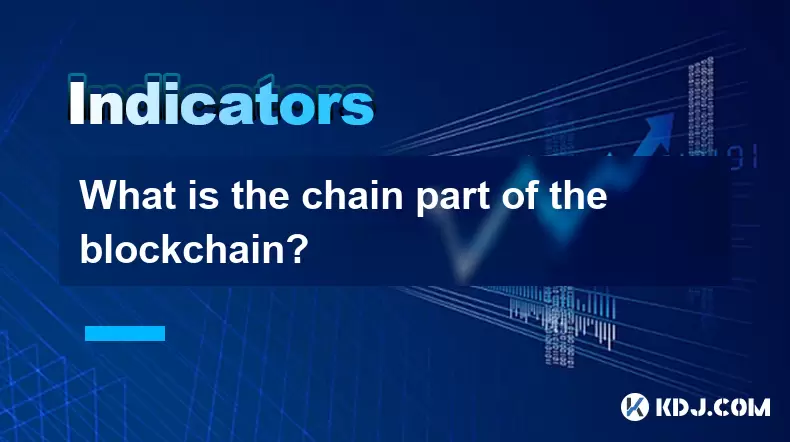
What is the chain part of the blockchain?
Aug 02,2025 at 09:29pm
Understanding the Concept of 'Chain' in BlockchainThe term 'chain' in blockchain refers to the sequential and immutable linkage of data blocks that fo...
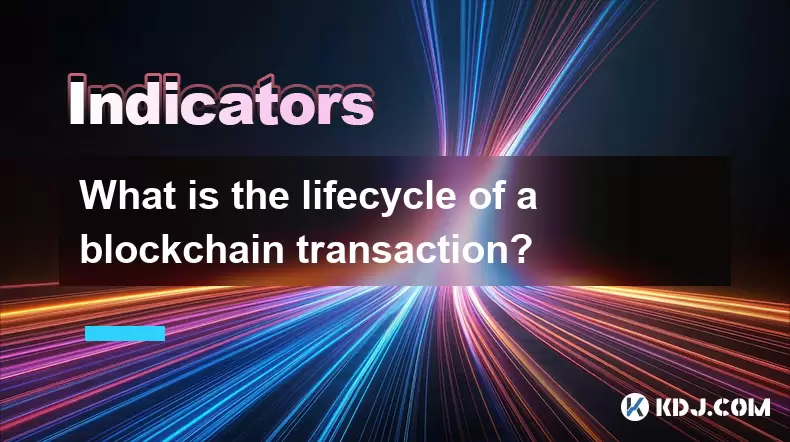
What is the lifecycle of a blockchain transaction?
Aug 01,2025 at 07:56pm
Initiation of a Blockchain TransactionA blockchain transaction begins when a user decides to transfer digital assets from one wallet to another. This ...
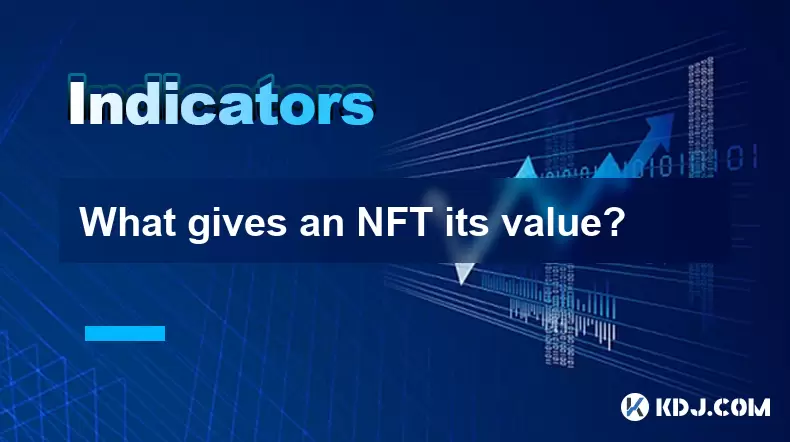
What gives an NFT its value?
Aug 02,2025 at 10:14pm
Understanding the Core Concept of NFTsA Non-Fungible Token (NFT) is a unique digital asset verified using blockchain technology. Unlike cryptocurrenci...
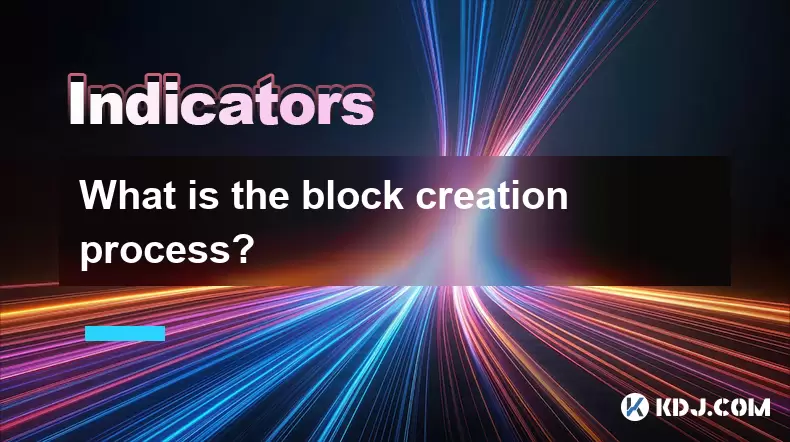
What is the block creation process?
Aug 02,2025 at 02:35am
Understanding the Block Creation Process in CryptocurrencyThe block creation process is a fundamental mechanism in blockchain networks that enables th...

Is it possible to alter or remove data from a blockchain?
Aug 02,2025 at 03:42pm
Understanding the Immutable Nature of BlockchainBlockchain technology is fundamentally designed to ensure data integrity and transparency through its ...

How do I use a blockchain explorer to view transactions?
Aug 02,2025 at 10:01pm
Understanding What a Blockchain Explorer IsA blockchain explorer is a web-based tool that allows users to view all transactions recorded on a blockcha...

What is the chain part of the blockchain?
Aug 02,2025 at 09:29pm
Understanding the Concept of 'Chain' in BlockchainThe term 'chain' in blockchain refers to the sequential and immutable linkage of data blocks that fo...

What is the lifecycle of a blockchain transaction?
Aug 01,2025 at 07:56pm
Initiation of a Blockchain TransactionA blockchain transaction begins when a user decides to transfer digital assets from one wallet to another. This ...

What gives an NFT its value?
Aug 02,2025 at 10:14pm
Understanding the Core Concept of NFTsA Non-Fungible Token (NFT) is a unique digital asset verified using blockchain technology. Unlike cryptocurrenci...

What is the block creation process?
Aug 02,2025 at 02:35am
Understanding the Block Creation Process in CryptocurrencyThe block creation process is a fundamental mechanism in blockchain networks that enables th...
See all articles

























































































